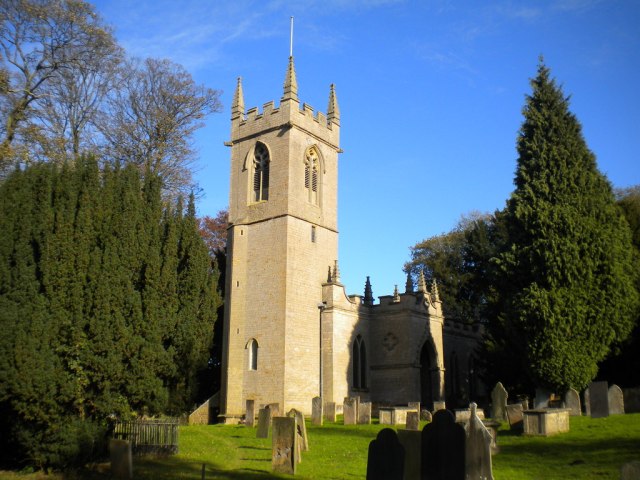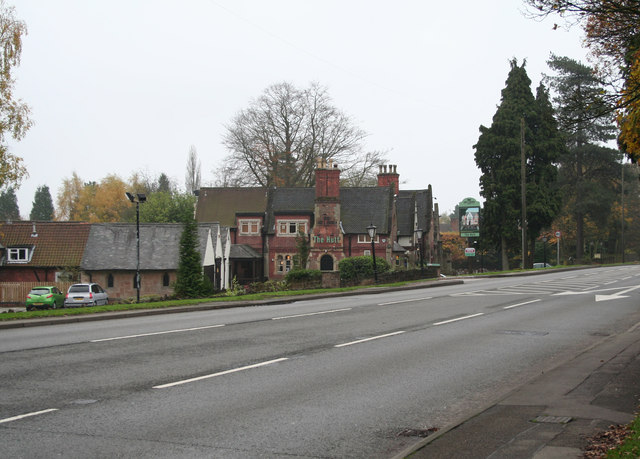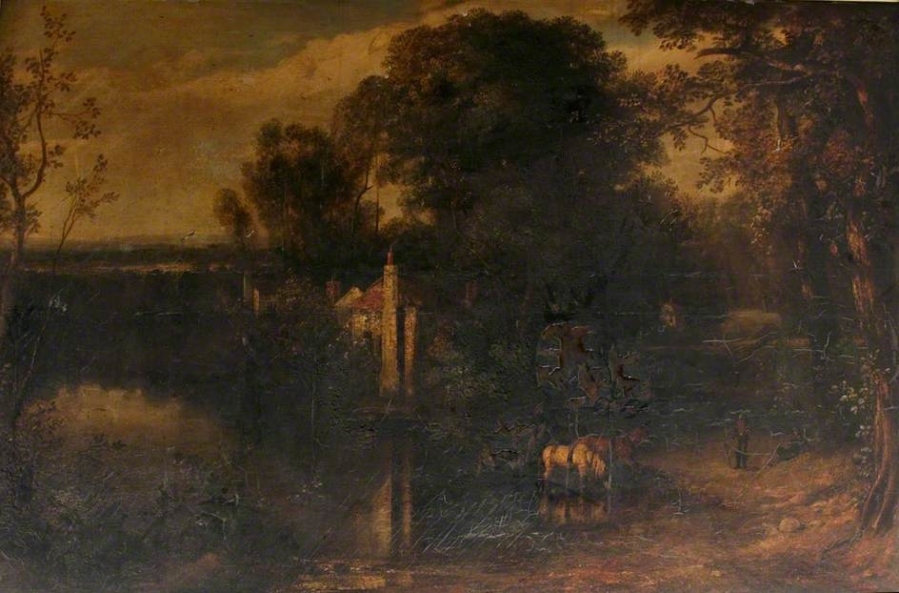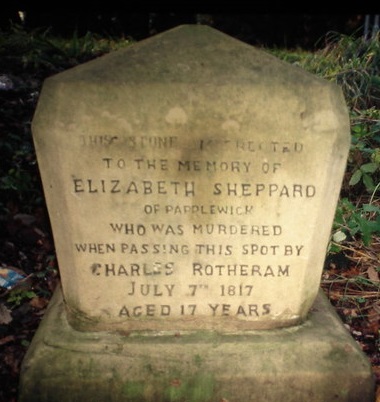Many people in Nottinghamshire will have travelled past the stone marking Elizabeth Sheppard’s death in 1817 and not even noticed it as it is now hidden in the undergrowth. As a teenager I passed the stone every day on my way to school but never really knew anything about who she was or why there was a stone there, but I had heard about her ghost that was said to haunt the A60 where she died with reports of motorists stopping to offer a girl a lift, when she simply disappeared.
The story was well documented at the time and has continued to fascinate ever since. Stories normally only make it onto our blog if they contain at least one new fact, however, we have made an exception in this case as it’s such a tragic story that we think will be of interest and also quite simply because we can!
Newspapers of the day described the girl in this story as Elizabeth Shepherd, not Sheppard which seems strange that they should have got her name wrong in such an important trial. There was a baptism in 1799 for an Elizabeth Shepherd which I think was in all likelihood her, daughter of Richard and Molly. Her burial in the parish records at Papplewick also recorded her as Shepherd.

On Monday the 7th July 1817 Elizabeth left her home in the village of Papplewick, Nottinghamshire, to walk to the town of Mansfield some 7 miles away, to seek employment as a servant. She was successful in her mission and began the long walk home – but she never made it back. About 4 miles from home Elizabeth, known as Bessie, was attacked by a Charles Rotherham.
Charles Rotherham, aged about 33, was a former soldier from Sheffield, who having fought in the Napoleonic Wars had taken up the occupation of a scissor grinder, so was presumably earning a living by travelling around the country sharpening knives. There was no reason offered in the newspaper reports as to why he was in that area so we can only presume his trade had led him there.
According to the newspaper reports Rotherham, without a word and with no apparent motive, attacked Bessie with a hedge-stake. He beat her until she died. The Lancaster Gazette and General Advertiser described Bessie as being ‘an interesting girl of 17’ and Rotherham as ‘a monstrous assassin’.
Having found no money upon her person, he stole her new shoes, ones she was wearing for her interview, and her umbrella and threw her body into a ditch. Apparently, shortly after having committed such an appalling crime he continued his journey toward Nottingham, stopping at The Hutt, an Inn, (opposite the entrance to Newstead Abbey, which was until 1816, owned by Lord Byron), for a drink, having passed Bessie’s mother who had set off in search of her daughter who was later than expected. According to the newspapers Bessie’s mother had seen a man with an umbrella on his arm.

When her body was found the following day in a ditch, it was described as being in a dreadful state with her brain protruding from her skull, one eye knocked out of the socket. Rotherham was quickly pursued and arrested, by Constable Benjamin Barnes, at which time Rotherham allegedly said ‘I am guilty of the crime and must suffer the course of the law’. He was taken to the scene of the crime and showed the officer the stake he had used, but could offer no explanation as to why he had done it, but his clothes showed signs of blood stains. He had money, 6 shillings in fact, in his pocket, so possibly money was not the motive, but he had successfully sold both her shoes and her umbrella.

At his trial he entered a plea of guilty, but for some reason the judge persuaded him to change his plea to not guilty. The case was heard, with ‘a considerable number of people called’ including Bessie’s mother; the newspapers reported him as being ‘resigned to his fate’. Right up to the time of his death Rotherham said he had no idea what made him commit such a heinous crime. He was visited by the Rev. Dr. Wood prior to the hanging and seemed to show remorse for what had happened. His fate, however, was sealed and he was hanged on the 28th July 1817 in Nottingham. Some 20,000 people attended the execution, after which his body was given over to a surgeon for dissection and was then interred at St Mary’s churchyard, Nottingham.
Rotherham left a wife, but no children, plus a brother and two sisters. According to the newspapers he had served as a solider for 12 years in the Artillery Corps and had been present in battles in Egypt, Portugal, Spain and France. Apparently on the day of the murder he had drunk 7 pints of ale in Mansfield before walking to the spot where the crime was committed.
Elizabeth was buried on the 10th July 1817 at St James’ parish church, Papplewick. The Lancaster Gazette and General Advertiser of 13th March 1819, a little under two years later, reported that the local community was so shocked by this murder that money was raised to purchase a stone so that her memory would live on.
On Tuesday night a neat monument was erected on Sherwood Forest, on the spot where this unfortunate female was murdered and on which was engraved the following inscription ‘this monument was erected in memory of Elizabeth Sheppard, of Papplewick, who was murdered on this spot by Charles Rotherham on the 7th July 1817 in the 17th year of her age.
The Bessie Sheppard Stone
Was he guilty? My view is that despite the evidence he was not guilty, surely if he had just beaten someone to death he would not have simply carried on walking to an inn, with blood stained clothes surely he would have wanted to avoid being seen. Wouldn’t Bessie’s mother have recognized the umbrella? Some reports state that Bessie was travelling from Mansfield towards Nottingham and that Rotherham was travelling towards Mansfield when the incident happened i.e. in the opposite direction, if that were the case, did he change his mind and head back toward Nottingham, if not then he could not have passed Bessie’s mother. It also raises the question as to why people felt compelled to mark her death with the stone, not many murders are marked in such a way.
The story of Bessie’s murder lingers on and there are still reported sightings of her ghost and as I grew up I was always aware of the legend that if the stone were ever moved from that spot that she would appear – to answer your question, no, I never saw her ghost.


Thanks for the story.I am not so sure that if it was a small community and a much loved, well known villager from a ‘good’ family, that once in a while the folks might club together to commemorate her.
I would respectfully disagree about his innocence. Without wishing to speculate too greatly, and in the absence of forensics or medical testimony, this sounds like an oportunist rape murder while under the influence of alcohol. He did say he did it. I bet that even if there was evidence there might have been good reason to withhold it from the trial or its reporting. And as to whether he was going in the direction of Mansfield, it won’t be the first nor the last time that a witness — or a reporter — got it wrong.
More stories like this please…
LikeLike
Thank you so much for your comments. You may well be correct in that he was guilty, it’s purely a feeling I have right now. There was no mention of rape as far as I have read from the newspaper articles I understand that she was beaten to death, seemingly with no clear motive on his part.
I do plan to check the local press next time I go to Nottingham to see if there are any more clues & if so there will be an update 🙂
We’ll do our best to find some more stories like this 🙂
LikeLike
You prompted me to have a look at contemporaneous reporting of the “horrid murder”. There was a syndicated story (I found it it the Hull Packet and the Oxford University and City Herald on 22 and 19 July respectively. The report says: “Some quarry-men, going to work the nest morning, near the spot, observed some halfpence lying on the ground, which induced them to look further, when, their astonishment and horror, the mangled body met their sight, through the hedge, lying as above described. A gentleman and lady, who happened to travelling by in gig, shortly afterwards, and saw the body, gave information of the circumstance, at the Police Office, immediately their arrival, and the most active steps were instantly taken to trace out and secure the murderer. From the disordered state of the poor creature’s dress, when found, there is reason to conclude, that her assailant had made some attempt upon her chastity, and it is not improbable, that the efforts she made to resist him, had aroused the fury of the wretch, and determined him instantly to deprive her of life.”
Most of all I want to know what an “interesting girl” was. It has obvious changed its meaning, like ‘simple’. If I find an answer I’ll report back…
LikeLiked by 1 person
Hmm, that does seem to imply there was more to it than simply murder, so to speak. I’ve no idea yet what an ‘interesting girl’ meant, it could mean a variety of things couldn’t it
LikeLike
A fascinating piece – I grew up in Mansfield and have seen the memorial dozens of times without knowing the story behind it travelled.
LikeLike
So pleased you found it interesting 🙂
LikeLike
I stumbled upon this article upon Googling ‘things that ended in the Georgian era’! Happy to find another history blog that wants to investigate things too, so you are followed by Taking a Walk Through History!
Fascinating reading. Thank you. I wonder if the alcohol was the fault here that sent Rotherham into a murderous rage that led him to amnesia the next day? Too much beer, wine, ale, etc, can lead one into do what they really not meant to do (or did want to do, but had no ‘courage’).
Bless the community for putting up that headstone. That would make me curious as to know what happened too. Thanks for such a great article.
LikeLike
So pleased you found it of interest. It’s hard to say whether alcohol played a part in the murder, but it seems possible, alternatively it could be connected with his time spent in the army – PTSD as we would describe it today. Without more research into the case it’s hard to know at present, but if we find out more there will be a follow up to the post.
LikeLike
I, too came across this story via another blog (among others you’ve posted) at strangeco.blogspot.com. You always post such interesting stories! Sounds like a case of PTSD to me, too. You hear many similar stories nowadays about soldiers who come home ruined after being in combat. Vietnam had many such and I knew some personally, my son-in-law was one from the current era. That kind of violence does things to men’s minds, and he may even have had some sort of brain injury, or not have been all that sharp to start with. I know that at times those who did recruiting were not overly scrupulous about who they took for the military.
LikeLike
Thank you so much for your comments, we’re delighted that you enjoy our posts, we always try to post articles that are a little out of the ordinary. 🙂
LikeLike
As said, PTSD can react in many ways. I was in the army in the 60s. Stationed at Retford. To cut a long story short our commanding officer for no apparent reason, shot his wife and daughter then himself. Why, not drink was this a case of PTSD after seving in wars as he had. This could have easily been the case with Rotherham.
LikeLike
Thank you so much for taking the time to comment. In this case it seems unlikely that we’ll ever find the truth, but agree that he could have been suffering from PTSD. 🙂
LikeLike
Can I suggest you get hold of my book that deals solely with this murder within the context of Regency Britain and the aftermath of the war with Napoleon. It was published January this year and is available as either a Kindle book or in paperback form from Amazon.uk. A good number of the facts about the case in your piece are wrong. The book’s called “The Murder of Bessie Sheppard.”
Thanks.
LikeLike
Many thanks for the information about your book. We have pieced together our research from information widely available both online and in the newspapers of the day and have ended with a personal view on Charles Rotherham’s possible innocence. My we ask which of the facts in our article you disagree with?
LikeLike
Please see my email to you. Thanks.
Dave Marshall
LikeLike
Many thanks for the email you sent to us with additional information about the case.
For the benefit of our readers, the original texts relating to the murder go into greater depth than the newspaper reports we used to write our article.
David has obviously gone to great detail to find out more about this case, and rather than replicate his response to us here, we recommend getting hold of his book for anyone who is interested to find out more on poor Bessie and on Charles Rotherham.
LikeLike
Been nice to chat. Thanks for your time and interest.
LikeLiked by 1 person
The Murder of Bessie Sheppard. Great read, lots of research undoubtedly gone into it. I’m Richard, a stonemason whose spent years researching and who restored the stone. Im still in my doubts who actly did murder Elizabeth. Would love to step back to 6:52pm Monday July 7th 1817 and observe what really happened.
LikeLiked by 1 person
How lovely to hear from you Richard, we are aware of your work through Dave Marshall. Yes – if only a time machine were available!
LikeLike
I remember reading in the early 1970’s an article in the the local paper known as the Chronicle Advertiser ( the Chad) about mysterious happenings and sighting of strange creatures in the vicinity .for this reason I understand that a new headstone was erected and the sightings stopped .it would be good to locate these press articles !
Karl Lesh
Now of Newark
LikeLike
Just looked at a 2013 blog from Frank E Earp of Nottinghamhiddenhistoryteam regarding an earlier incident in this area involving a Robin Down and a reference to Bessie Sheppard shows a different headstone, ie shape ,carving etc.?
Which one is the original?
LikeLike
Many thanks Karl for both your messages. We would recommend reading the book written by Dave Marshall ‘The Murder of Bessie Sheppard: A True Story’ for more information about the story, he researched Bessie’s story for a good number of years and is an authority on it, so we’re sure that will help to fill in some of the gaps. Richard Morley has also been very much involved with this research and has restored the stone, he would probably be able to tell you which is the correct one, but there is definitely a difference between the two images and the spelling of Charles Rotherham’s name. Hopefully Dave and Richard will see your posts as they have both commented previously 🙂
LikeLike
Hi
Every photograph taken of the memorial to Bessie is the same stone.
The only difference now is the insertion of the slate plaque with the same original inscription. The reason for this is that the stone face was to soft to take an inscription without working about an inch off the surface.
Also the inscription on the slate will almost certainly last longer.
LikeLiked by 1 person
I wish I could see a portrait of Bessie
LikeLike
Yes, wouldn’t that be lovely. We’re not aware of one in existence though 😦
LikeLike
I never came across anything like that in the forty years prior to writing the book. The thing was, she was a girl of no significance, yet we were, for some reason, made to remember her by the stone being placed there. Now there’s a tale…..
LikeLiked by 1 person
Thanks Dave for the additional info 🙂
LikeLike
Never came across any image of her in the forty years up to writing the book. She was a girl of absolutely no consequence – and that’s the dilemma. Why were we made to remember her through a stone on the roadside? Therein lies a tale….
Sent from my iPad
>
LikeLike
After getting in touch with you on Twitter, Sarah, you kindly directed me to your blog on Besdie Sheppard. Thank you ☺ My question(s)are simply this – Where in Papplewick did Elizabeth (Bessie) live? Also, there is so much on her memorial stone but little info on where in the graveyard she might be buried… her gravestone? Any info would be hugely appreciated ☺☺
LikeLike
Hi. I’ve replied on Twitter, but just in case you’ve missed it on there. I’m not sure where she lived. She was buried in an unmarked grave near the tower, I believe. I would recommend reading David Marshall’s book about Bessie’s story, as he’s an expert on the subject. Hope this helps:)
LikeLike
Thank you so much, Sarah. I shall promptly purchase said novel. ☺
Phillip.D.Curwood (author)
LikeLiked by 1 person
Bessie lived with her Mother Mary and younger brother Joseph in either the brick row or stone row of cottages on moor lane, Papplewick.
Coming from Linby head to the Griffins head, turn right at the pub, travel about 700yrds and just after Papplewick lane on the right you will see the cottages set back off the road.
LikeLiked by 1 person
Thank you for the info, Richard… Going back to what others were saying about Charles Rotheram’s guilt – Why did the judge at his trial ask for him to plead “not guilty”?
LikeLike